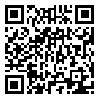Volume 11, Issue 1 (2007)
MJSP 2007, 11(1): 67-91 |
Back to browse issues page
Download citation:
BibTeX | RIS | EndNote | Medlars | ProCite | Reference Manager | RefWorks
Send citation to:



BibTeX | RIS | EndNote | Medlars | ProCite | Reference Manager | RefWorks
Send citation to:
Farajzadeh Asl M, Mirzabayati R. Possibility study of areas with potential cultivation of saffron in Nishabor plain using GIS. MJSP 2007; 11 (1) :67-91
URL: http://hsmsp.modares.ac.ir/article-21-8663-en.html
URL: http://hsmsp.modares.ac.ir/article-21-8663-en.html
1- Tarbiat Modares University, Tehran, Iran
2- Master in physical geography, Tarbiat Modarres University
2- Master in physical geography, Tarbiat Modarres University
Abstract: (6039 Views)
Saffron as the most expensive agriculture and medicinal product of world, is a plant in consider to aridity resistant has interesting role in social and economical status of arid and semi arid of southern and central Khorasan provinces. Relatively good income of this product, short period of cultivation and low level water need, farmers of Nishabor to intend to cultivate without attention to possibility and potentials of lands that has created some problems and low yields. In this paper, The areas with potential cultivations for saffron using altitude, slop gradient, land capacity, soil deep, access potential to surface and ground water maps and temperature thresholds affect in saffron are analyzed in GIS environment. In this purpose, different weighting method as ranking, rating and AHP calculate and related map produced. After comparing method, rating method as the best model was used to produce of final potential map. The result of this study indicates that about 2146 square km of lands plain has very good potential to develop saffron cultivation that in present statues, this lands specified to dry farming, irrigated farming, semi condense and condense ranglands. Land use changes to saffron, is created areas economical development.
Received: 2005/05/4 | Accepted: 2005/11/29 | Published: 2007/03/21
| Rights and permissions | |
 |
This work is licensed under a Creative Commons Attribution-NonCommercial 4.0 International License. |







